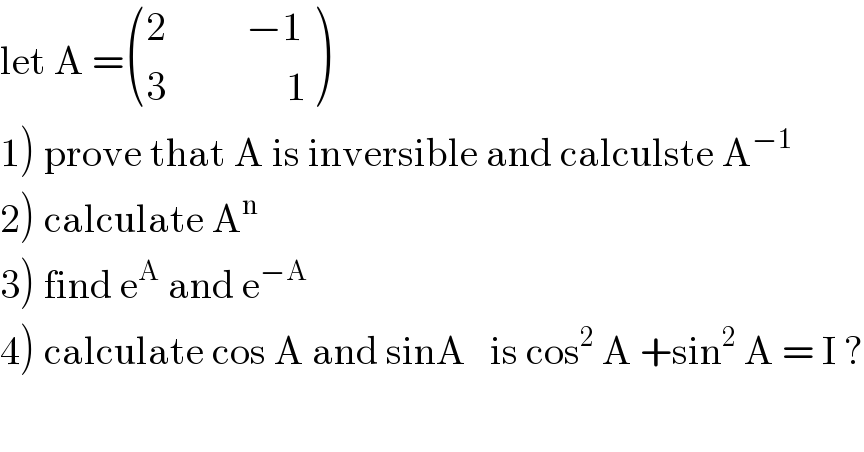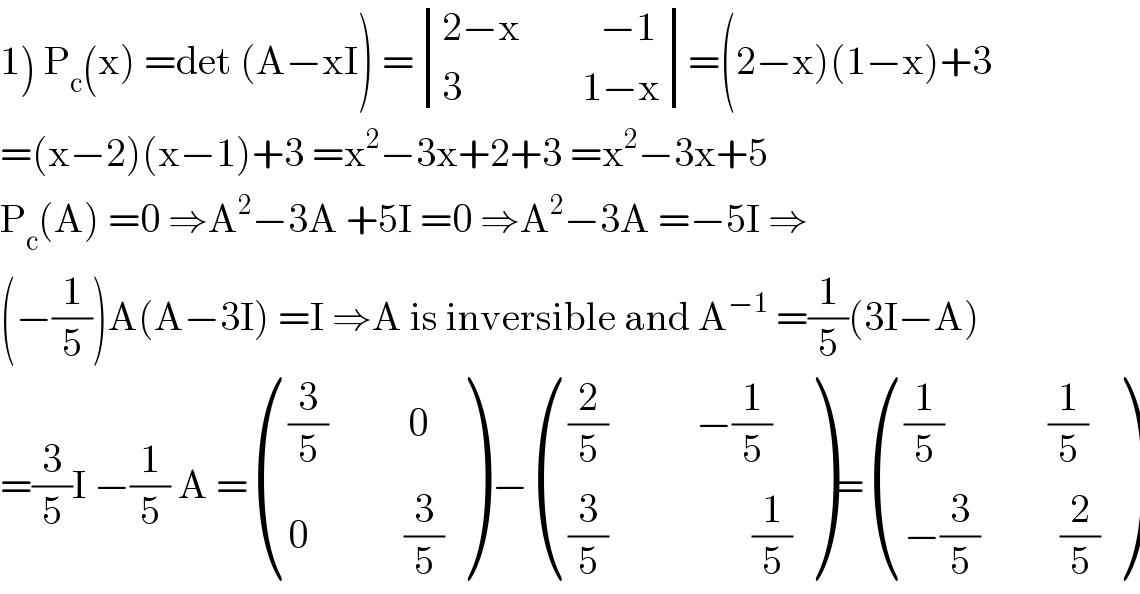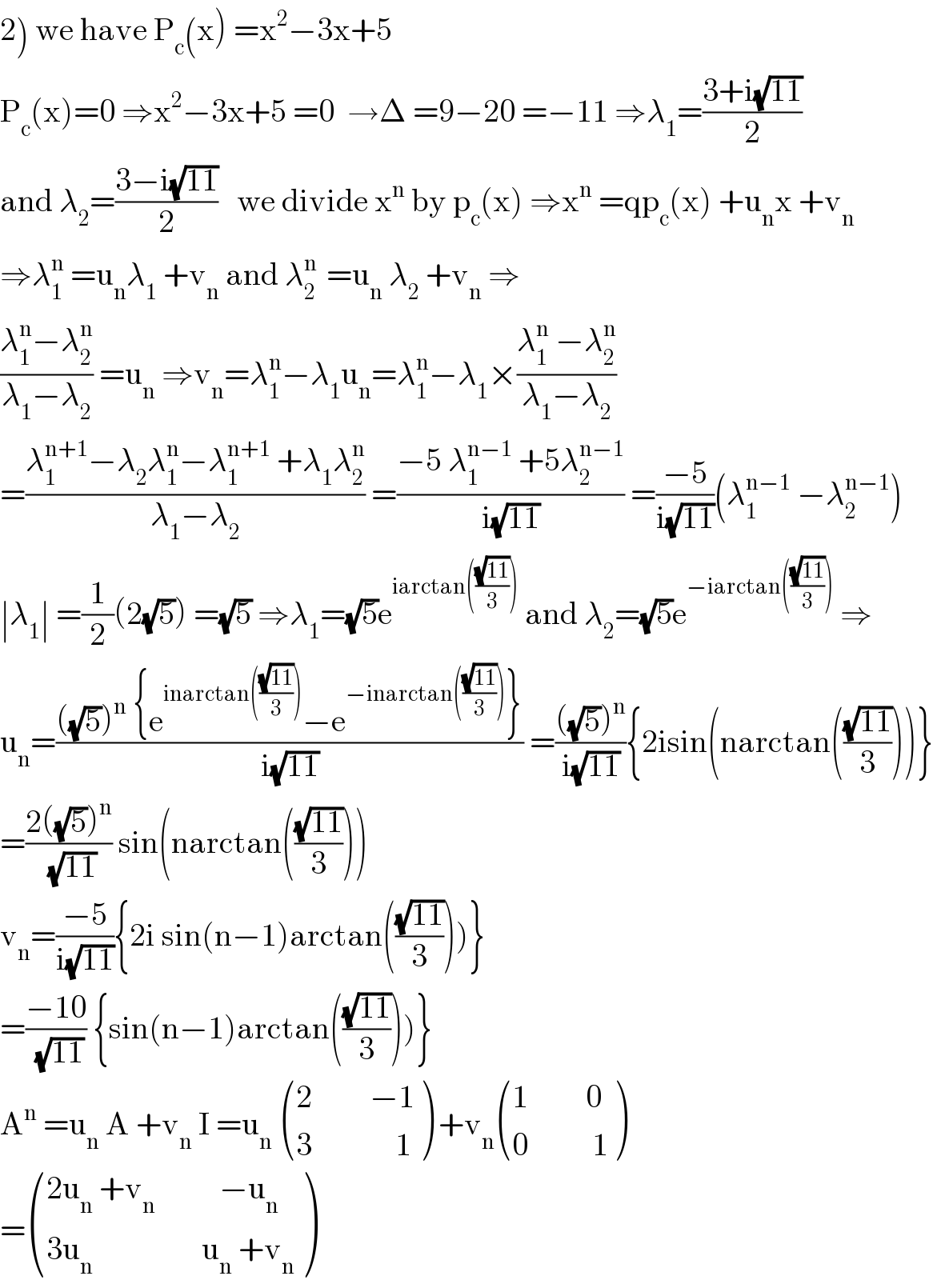Question Number 99580 by mathmax by abdo last updated on 21/Jun/20

Commented by john santu last updated on 22/Jun/20
![(1) det(A) ≠ 0 ⇒A^(−1) = (1/5) [(( 1 1)),((−3 2)) ]](https://www.tinkutara.com/question/Q99592.png)
Answered by MWSuSon last updated on 22/Jun/20
![1) ∣A∣=2+3=5≠0 ■ 2)A^n =PD^n P^(−1) ∣A−λI∣= determinant (((2−λ),(−1)),(3,(1−λ)))=0 (2−λ)(1−λ)+3=0 λ=(1/2)(3±i(√(11))) when λ=(1/2)(3+i(√(11))) let B= ((((1/2)−i((√(11))/2)),(−1)),(3,(−(1/2)−((i(√(11)))/2))) ) BX^→ = ((((1/2)−i((√(11))/2)),(−1)),(3,(−(1/2)−((i(√(11)))/2))) ) [(x_1 ),(x_2 ) ]= [(0),(0) ] augmented matrix ((((1/2)−((i(√(11)))/2)),(−1),0),(3,(−(1/2)−((i(√(11)))/2)),0) )= [(x_1 ),(x_2 ) ] by gaussian elimination R2→R2−(3/((1/2)−((i(√(11)))/2)))R1 and R1→(2/(1−i(√(11)))) = ((1,(−(2/(1−i(√(11)))))),(0,0) ) [(x_1 ),(x_2 ) ]= [(0),(0) ] x_1 −((2x_2 )/(1−i(√(11))))=0 x_1 =((2x_2 )/(1−i(√(11)))) X^→ = [(((2ix_2 )/(i+(√(11))))),(x_2 ) ],let x_2 =1 X^→ = [(((2i)/(i+(√(11))))),(1) ] fellowing same procedure second eigenvector X^→ = [((−((2i)/( (√(11))−i)))),(1) ] P= [(((2i)/( (√(11))+i)),(−((2i)/( (√(11))−i)))),(1,1) ] P^(−1) = [(((3i)/( (√(11)))),((1/2)−(i/(2(√(11)))))),((−((3i)/( (√(11))))),((1/2)+(i/(2(√(11)))))) ] D=P^(−1) AP D= [(((1/2)(3+i(√(11)))),0),(0,((1/2)(3−i(√(11))))) ] Hence A^n = [(((2i)/( (√(11))+i)),((2i)/(i−(√(11))))),(1,1) ] [((((1/2))^n (3+i(√(11)))^n ),0),(0,(((1/2))^n (3−(√(11)))^n )) ] [(((3i)/( (√(11)))),((1/2)−(i/(2(√(11)))))),((−((3i)/( (√(11))))),((1/2)+(i/(2(√(11)))))) ]](https://www.tinkutara.com/question/Q99593.png)
Commented by MWSuSon last updated on 22/Jun/20
you are welcome sir.
Commented by abdomathmax last updated on 22/Jun/20

Answered by MWSuSon last updated on 22/Jun/20
![if A= [(a_(11) ,a_(12) ),(a_(21) ,a_(22) ) ]= [(2,(−1)),(3,1) ] then e^A = [(e^a_(11) ,e^a_(12) ),(e^(a21) ,e^a_(22) ) ]= [(e^2 ,(1/e)),(e^3 ,e) ] e^(−A) = [((1/e^2 ),e),((1/e^3 ),(1/e)) ] 4)cosA= [((cos(a_(11) )),(cos(a_(12) ))),((cos(a_(21) )),(cos(a_(22) ))) ]= [((cos2),(cos1)),((cos3),(cos1)) ] sinA= [((sin2),(−sin1)),((sin3),(sin1)) ]. yes cos^2 A+sin^2 A=I](https://www.tinkutara.com/question/Q99594.png)
Answered by MWSuSon last updated on 22/Jun/20
![e^A =Pe^D P^(−1) e^(−A) =Pe^(−D) P^(−1) ⇒e^A = [(((2i)/( (√(11))+i)),((−2i)/( (√(11))−i))),(1,1) ] [(e^((1/2)(3+i(√(11)))) ,0),(0,e^((1/2)(3−i(√(11)))) ) ] [(((3i)/( (√(11)))),((1/2)−(i/(2(√(11)))))),((−((3i)/( (√(11))))),((1/2)+(i/(2(√(11)))))) ] ⇒e^(−A) = [(((2i)/( (√(11))+i)),((−2i)/( (√(11))−i))),(1,1) ] [(e^(−(1/2)(3+i(√(11)))) ,0),(0,e^(−(1/2)(3−i(√(11)))) ) ] [(((3i)/( (√(11)))),((1/2)−(i/(2(√(11)))))),((−((3i)/( (√(11))))),((1/2)+(i/(2(√(11)))))) ]](https://www.tinkutara.com/question/Q99597.png)
Answered by mathmax by abdo last updated on 22/Jun/20

Commented by mathmax by abdo last updated on 22/Jun/20

